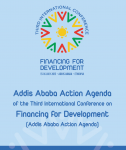 16 April 2016: The heads of nine multilateral development banks (MDBs), UN high-level officials, ministers, development partners and representatives of the G20, G24 and G77 gathered to discuss ways of enhancing multilateral collaborative mechanisms to improve infrastructure delivery globally, during the inaugural Global Infrastructure Forum 2016 (GIF). A Chair’s Statement was issued following the meeting, setting out next steps in collaboration.
16 April 2016: The heads of nine multilateral development banks (MDBs), UN high-level officials, ministers, development partners and representatives of the G20, G24 and G77 gathered to discuss ways of enhancing multilateral collaborative mechanisms to improve infrastructure delivery globally, during the inaugural Global Infrastructure Forum 2016 (GIF). A Chair’s Statement was issued following the meeting, setting out next steps in collaboration.
The GIF took place on 16 April 2016, in Washington DC, US, during the World Bank Group-International Monetary Fund (IMF) Spring Meetings 2016. The participant MDBs were African Development Bank (AfDB), Asian Development Bank (ADB), Asian Infrastructure Investment Bank (AIIB), European Bank for Reconstruction and Development (EBRD), European Investment Bank (EIB), Inter-American Development Bank Group (IDB), Islamic Development Bank (IDB), New Development Bank, and the World Bank Group.
During the opening session, Jim Kim, President of the World Bank Group, stressed the need to: help countries with good governance, capacity building and reducing transactions costs; set international standards of disclosure and transparency; and give MDBs more flexibility when identifying projects and the needed instruments, as they are the “leveraging machines.” Kim further observed greater willingness to invest in middle-income countries (MICs) because of the ongoing refugee crisis.
UN Secretary-General Ban Ki-moon noted that the GIF is one of the major deliverables of the Addis Ababa Action Agenda (AAAA), which together with the 2030 Agenda for Sustainable Development and the Paris Agreement on climate change were devised to change the global economy, expand opportunities, and leave a healthier planet for future generations. Ban called for deliberations to include developing countries so no one is left behind, and invited GIF participants to consider how their institutions are responding to those most in need.
The MDB leaders stressed the need for: setting quantitative goals for qualitative actions; mobilizing the private sector and all sources for development from all partners; transparency; effective governance frameworks; optimizing investments; mobilizing resources existing in domestic and regional capital markets; better designing and integrating sustainable infrastructure in procurement systems; harmonization of standards among MDBs; better return on equity financing; offering a mix of lending, blending and advising; changes in MDBs’ governance and representation so that shareholders allow partners who want to invest more to do it; avoiding the accumulation of public debt; standardizing infrastructure contracts to enable scaling up, as investors have started seeing them as an asset class; and increasing tax compliance.
According to the Chairman’s Statement, the MDBs are committed to working with countries and investors to support the provision of greater access to, and better quality of, affordable infrastructure services which are environmentally, socially, and economically sustainable. The Statement further explains that they will do this through a two-pronged approach. First, they will continue to support country-led approaches to planning, executing, supervising, and evaluating “well-prioritized” infrastructure programs and infrastructure frameworks, as well as the involvement of all stakeholders in planning, financing through domestic resource mobilization and national/international financing.
Secondly, they will consolidate and scale up “where possible” existing multilateral mechanisms to promote greater knowledge transfer, project preparation, and implementation support in the form of global and regional platforms and tools, including de-risking and risk allocation mechanisms, that have already been developed in cooperation by MDBs. Examples offered by the Statement included: the Global Infrastructure Facility, the Global Infrastructure Hub, the International Infrastructure Support System, the PPP Knowledge Lab, Infrascope, the PPP Certification program, and environmental, social and governance standards.
To achieve the objectives of the GIF, the MDBs resolve the following: improving data and information on infrastructure, including through working together with client countries to improve data acquisition and develop systematic reporting; promoting compatible, efficient approaches including by reducing transaction costs of building and implementing sustainable infrastructure and by continuing the promotion of efficient approaches to key bottlenecks or constraints; strengthening project preparation; and promoting financing for infrastructure.
The Chair’s Statement also notes that the outcomes of the GIF will be reported to UN Member States via the UN Economic and Social Council’s (ECOSOC) Forum on Financing for Development (FfD) follow-up. The FFD Forum’s inaugural session is taking place in New York, US, from 18-20 April 2016.
The GIF was mandated by the AAAA to help bridge the infrastructure gap, which was viewed as critical for achieving the Sustainable Development Goals (SDGs). The GIF aims to provide a forum for countries and development partners to work together by building on existing multilateral collaboration mechanisms, and to improve alignment and coordination among established and new infrastructure initiatives, multilateral and national development banks, UN agencies, national institutions, development partners, and the private sector. The Forum will be held annually, with the responsibility for hosting rotating among the MDBs. [GIF Chair’s Statement] [World Bank Group GIF Webpage] [IDB Press Release] [UN Secretary-General Remarks] [IISD RS Sources] [Addis Ababa Action Agenda]